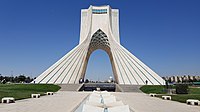
Photo from wikipedia
Abstract Increasing use of energy consumption, carbon emission, thermal uncomfortability in densely populated metropolitan centre is not only an emerging challenge but also in the meso and micro level towns.… Click to show full abstract
Abstract Increasing use of energy consumption, carbon emission, thermal uncomfortability in densely populated metropolitan centre is not only an emerging challenge but also in the meso and micro level towns. The present work wants to investigate is the anthropogenic heat flux as additional heat in radiation energy balance carried an important role to alter the thermal environment of the English Bazar town and its peripheral areas? Is this heat flux increasing over advancing of time? Is this heat flux distinguishable over different land use/ land covers? Calculated anthropogenic heat flux from remotely sensed satellite data reveals that maximum anthropogenic heat flux is increased from 54.52 W/m2 to 188 W/m2 in between 1990 and 2017. Core urban area, commercial units, high rise densely populated built up areas discharge maximum anthropogenic heat flux (>120 W/m2). Clear heat flux gradient is observed from urban mainland to peripheral sub urban areas. Natural units like vegetated areas, water bodies are recorded zero anthropogenic heat flux. Increasing trend of anthropogenic heat addition to the urban climate will make the situation more uncomfortable in coming days and therefore, stress should be given on clean technologies and use of solar energy to slacken down thermal annoyance.
Journal Title: Remote Sensing Applications: Society and Environment
Year Published: 2018
Link to full text (if available)
Share on Social Media: Sign Up to like & get
recommendations!